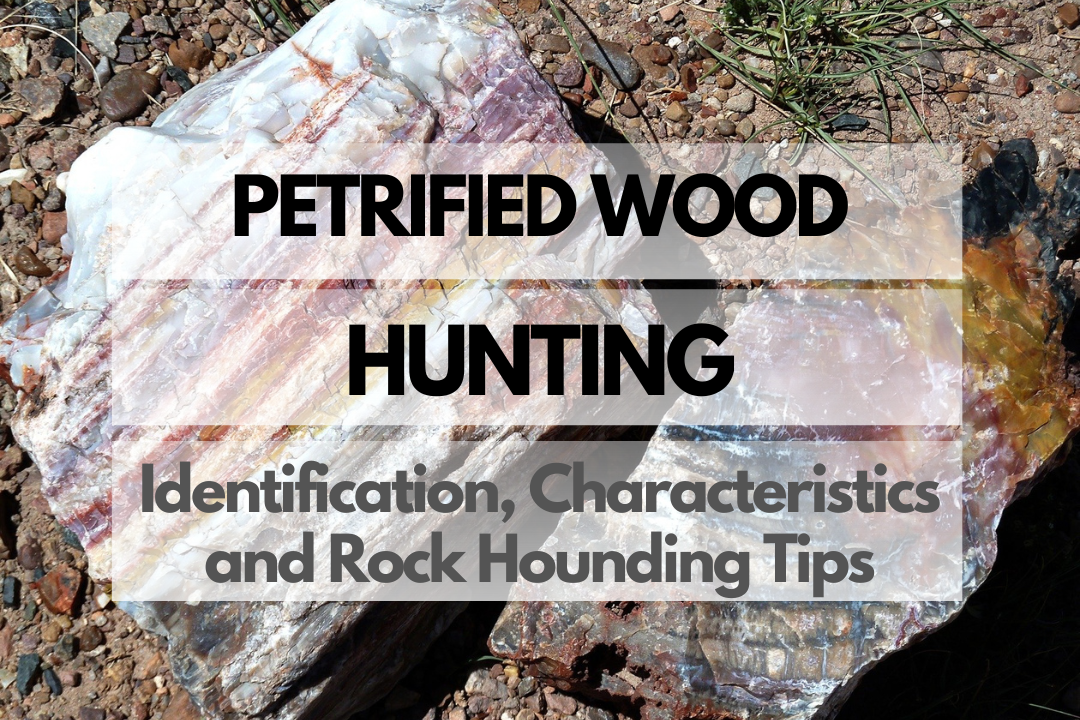There’s something magical about finding a piece of history hidden in the Earth. When that piece of history is a piece of petrified wood, the excitement is even greater! Get ready to embark on a captivating journey as we explore the fascinating world of petrified wood hunting, identification, characteristics, and rock hounding tips. So grab your tools, pack your bags, and let’s go on a thrilling adventure to unearth these hidden treasures!
History & Origin of Petrified Wood
Petrified wood is a type of fossil that forms when trees or tree-like plants are buried by sediment and mineral-rich water gradually replaces the original organic material with minerals. This process, known as permineralization, can take millions of years. Petrified wood has been found worldwide, with some of the most famous deposits located in the Petrified Forest National Park in Arizona, USA. The term “petrified” comes from the Greek word “petros,” meaning “rock” or “stone,” and describes the transformation of organic material into stone.
Petrified Wood Identification & Physical Properties
| Property | Description |
|---|---|
| Color | Varies, commonly in shades of brown, red, yellow, and black |
| Hardness | 6.5-7.5 on the Mohs scale |
| Crystal System | Amorphous (no regular crystal structure) |
| Luster | Vitreous to waxy |
| Transparency | Opaque |
Petrified Wood Colors
Petrified wood comes in a wide range of colors, including various shades of brown, red, yellow, and black. The colors are influenced by the minerals present during the petrification process. For example, iron oxides can create red and yellow hues, while manganese and carbon can produce black and dark grey colors.
Petrified Wood Hardness
Petrified wood has a hardness of 6.5-7.5 on the Mohs scale, which means it’s harder than most common rocks and minerals. This hardness is due to the replacement of the original organic material with minerals, such as quartz, which is quite hard and durable.
Petrified Wood Types
Coniferous Petrified Wood
Coniferous petrified wood comes from ancient conifer trees, such as pines and cedars. This type of petrified wood often displays well-preserved wood grain patterns and can be found in various shades of brown, red, and yellow.
Angiosperm Petrified Wood
Angiosperm petrified wood comes from ancient flowering plants. This type of petrified wood can have a more intricate wood grain pattern and a wider range of colors, including shades of blue, green, and purple, due to the presence of different minerals during the petrification process.
Petrified Wood Uses
- Jewelry: Polished petrified wood is often used to create beautiful and unique pieces of jewelry, such as pendants, earrings, and rings.
- Home décor: Large pieces of petrified wood can be turned into stunning furniture, such as tables and benches, or used as decorative accents in homes and gardens.
- Collecting: Petrified wood is a popular item for collectors, who appreciate its natural beauty and fascinating history.
- Scientific study: Petrified wood provides valuable information about Earth’s ancient ecosystems and climate, as well as the evolution of plant life.
How Much Is Petrified Wood Worth?
The value of petrified wood varies widely, depending on factors such as size, color, quality, and rarity. Small, common pieces might cost just a few dollars, while larger, more colorful specimens can fetch hundreds or even thousands of dollars. Ultimately, the price of petrified wood is determined by what collectors are willing to pay for a particular piece.
Petrified Wood Rock Hounding Tips
Ready to start your petrified wood hunting adventure? We’ve got you covered! In this section, we’ll provide you with essential tips and tricks to make your hunt a success. From essential tools and equipment to safety advice, and the best places to find petrified wood, we have everything you need to know to embark on this exciting journey.
Essential Tools and Equipment
- Rock hammer: A rock hammer is crucial for breaking and chipping away at rocks during your hunt.
- Chisel: A chisel can help you carefully extract petrified wood from the surrounding rock or sediment.
- Safety goggles: Always wear safety goggles to protect your eyes from flying debris.
- Rock pick: A rock pick can be useful for digging and prying at rocks and soil.
- Hand lens or magnifying glass: This will help you closely examine your finds to identify petrified wood.
- Backpack or collection bag: Bring something to carry your finds in, as well as any other essentials like water and snacks.
- Gloves: Gloves can protect your hands from sharp rocks and improve your grip on tools.
Safety Tips
- Always let someone know where you’re going and when you plan to return.
- Wear sturdy shoes with good traction to avoid slipping on loose rocks or steep terrain.
- Stay hydrated and bring plenty of water, especially in hot or dry environments.
- Be aware of your surroundings and watch out for hazards such as loose rocks, steep cliffs, or dangerous wildlife.
- Never go rock hounding alone. Bring a friend or join a group to ensure safety in case of an emergency.
Petrified Wood Hunting: Where to Find Petrified Wood
While petrified wood can be found in many places around the world, certain locations are particularly well-known for their abundance of high-quality specimens. Some of the best places to find petrified wood include the United States, Argentina, Madagascar, and Australia. Let’s explore specific sites and regions where you can find these incredible fossils:
| Site/Area | City/State/Country |
|---|---|
| Petrified Forest National Park | Arizona, USA |
| Mississippi Petrified Forest | Flora, Mississippi, USA |
| Escalante Petrified Forest State Park | Utah, USA |
| La Leona Petrified Forest | Patagonia, Argentina |
| Isalo National Park | Madagascar |
| Lune River | Tasmania, Australia |
Caring For Your Petrified Wood
Once you’ve found some beautiful petrified wood specimens, you’ll want to take care of them to preserve their natural beauty. Here are some tips for cleaning and caring for your petrified wood:
- Wash your petrified wood with water and a soft brush to remove any dirt or debris.
- Allow your specimens to air dry completely before storing or displaying them.
- Store your petrified wood in a cool, dry place, away from direct sunlight to avoid fading.
- For display, consider using a stand or a cushioned surface to prevent scratches.
Additional Resources
- Government resources: National Park Service Fossils
- Scientific articles: ScienceDirect Petrified Wood Articles
- Forums and communities: Mindat.org
- Books: “Petrified Wood: The World of Fossilized Wood, Cones, Ferns, and Cycads” by Frank J. Daniels
Additional Petrified Wood FAQs
What are the benefits of Petrified Wood?
Petrified wood is valuable for its scientific, educational, and aesthetic qualities. It provides important information about Earth’s history, ancient environments, and past life forms. Collectors and enthusiasts appreciate its unique patterns, colors, and textures, making it a popular choice for home decor and jewelry.
Do Petrified Wood have any healing properties?
While there’s no scientific evidence to support the healing properties of petrified wood, some people believe it can help with grounding, stability, and connecting with nature. It’s often used in meditation and energy work for these purposes.
Do Petrified Wood have any spiritual meaning?
Petrified wood is often associated with qualities like strength, grounding, and transformation. It’s said to help individuals connect with their roots and find stability in their lives, while also symbolizing the process of growth and change.
Do I need a permit to go Petrified Wood hunting?
In some areas, you may need a permit to collect petrified wood, especially on public lands. It’s important to research the regulations and obtain any necessary permits before you begin your hunt. For more information on obtaining a permit in the United States, visit the Bureau of Land Management’s Rocks, Minerals, and Paleontology page.
Closing Thoughts
With all the knowledge and resources provided in this article, you’re now ready to embark on your petrified wood hunting adventure! Remember to be prepared with the proper tools and equipment, stay safe, and respect local regulations. The world of petrified wood offers a fascinating glimpse into Earth’s history, and you never know what amazing treasures you’ll find. So go out, explore, and have fun on your rock hounding journey!

